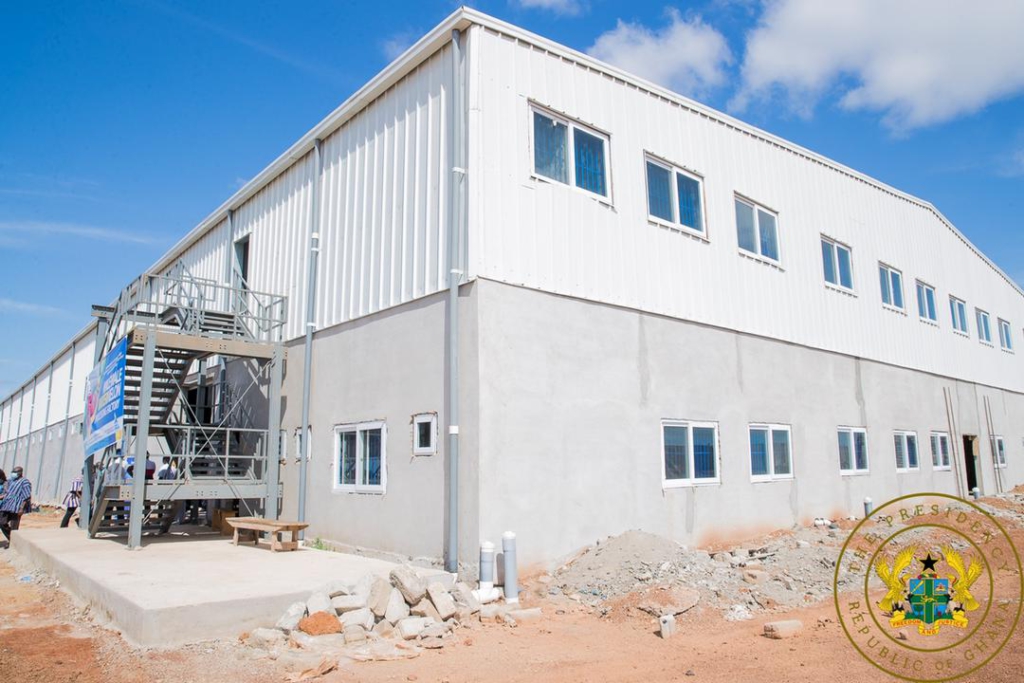President Akufo at the commencement of his 2-day tour of the North East Region expressed satisfaction with work so far undertaken on the construction of a GH¢36 million watermelon juice factory, being established in Walewale in the North East Region.
Akufo Addo visited Champion Foods and Beverages Limited, a wholly owned Ghanaian beverage manufacturing, distribution and marketing company.
The President was informed that the company is employing the use of PET line technology, as compared to the Tetra Packs technology, and it is being financed with a facility from the Ghana EXIM Bank.
With minor construction works to be undertaken, President Akufo-Addo was informed that the overall project is 90% complete, with offices and staff accommodation at 80% completion, and plant, equipment, and machinery all on site ready to be installed.
Full operationalization of the factory has been deferred to March 2022, with the company having installed a 10 metric tonnes per hour facility.
It is expected that, upon completion, the company will create direct employment opportunities for 300 Ghanaians and over 2,000 indirect workers, including farmers and aggregators, to be engaged in an out-grower scheme, covering parts of North East, Northern and other Regions of the country.
1D1F TAMANA RICE FACTORY
The President also visited Tamanaa Company Ltd., a rice farming and processing company located in Nasia near Walewale, which is also operating under Government’s 1-District-1-Factory initiative.
As a result of the support received from Government, the company has been able to expand its operations, by adding a 250-metric ton per day rice milling facility, to its already existing 40 metric ton per day plant.
So far, some 148 workers have been employed, with the company generating a turnover of some $1.5 million annually. The company markets 60% of its rice as parboiled and the remaining 40% as non-parboiled under the brand name Nasia Star Rice.
Tamanaa company currently engages over 4,000 rice farmers and aggregators operating in the West Mamprusi, East Mamprusi, Savulugu, Nanton and Mamprugu-Moagduri Districts.

1D1F Initiative:
The One District One Factory (1D1F) initiative is the vision of His Excellency the President, Nana Addo Dankwa Akufo-Addo to change the nature of Ghana’s economy from one which is dependent on import and export of raw material to one which is focused on manufacturing, value addition and export of processed goods. These raw materials are largely found in the districts which would have otherwise gone waste.
The initiative as proposed by His Excellency Nana Addo Dankwa Akufo-Addo is private sector led. Government creates the necessary conducive environment for the businesses to access funding from financial institutions and other support services from Government agencies to establish factories. Ghanaian entrepreneurs will thus own the companies, operate them and bear all the risks and rewards of the projects.
On 25th August, 2017, His Excellency the President launched the 1D1F programme at Ekumfi in the Central Region. His Excellency after the launching, cut sod for the commencement of the first factory, a pineapple/ fruit processing factory at Nanabeng in the Central Region of Ghana.
Objectives
The 1D1F initiative seeks to achieve the following;
- Add value to the natural resources of each district and exploit the economic potential of each district based on its comparative advantage.
- Ensure even and spatial spread of industries that would stimulate economic activity in different parts of the country.
- Create massive employment particularly for the youth in rural and peri-urban communities, and thereby improve income levels and standards of living, as well as reduce rural-urban migration.
- Promote exports and increase foreign exchange earnings.
- Enhance the production of local substitutes for imported goods thereby conserving scarce foreign exchange.







